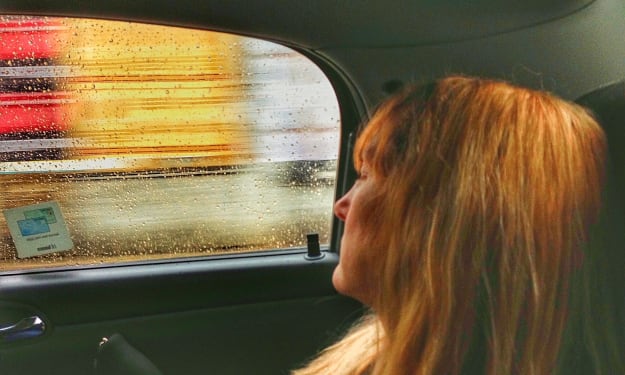A STUDY IN THE EDWARDIAN ERA
THE EDWARDIAN ERA

The Edwardian Era is my favourite Era in English history. It was a time when the old crossed over into the new and “life” started to change into the modern world in which we live today. Photography was in its infant stage but we still have these amazing pictures of the old and new, the horse and cart with the motor car (for example) in the one photograph. These old, sepia photographs have opened the door to the Edwardian Era, helping us to understand the importance of this “part” of English history, and giving us “living” pictures of how people lived back then. The pictures of the dresses are exquisite and yet, just as interesting is how these photographs showed the difference in how these “classes” lives, what they wore and where they worked.
Of course, these biggest differences are seen better in the Victorian Era and the photographs taken then, Yet, when Queen Victoria died and her eldest son, Edward VII, came to the throne, this is when we see life starting to really change. It was such an exciting time of experiments and inventions, many of which is used today.
EDWARD VII
Edward VII --- the King of the Edwardian Era --- was the perfect monarch for this time, hence the name “The Edwardian Era.” Although 59 years of age when he came to the throne, Edward VII was already very well-known, well-liked and a very forward-moving monarch. Being only a child when Edward VII came to the throne, J.B.Priestly recalled:” I can testify to his (Edward VII’s) extraordinary popularity, he was in fact the most popular king England had known since the earlier 1600’s.”
The eldest son of Queen Victoria and Prince Albert, Edward was born at 10.48 in the morning of 9th November, 1841, in Buckingham Palace. Being christened Albert Edward on 25th January, 1842, he was expected to take this name when he became king. However, Edward declined being called Albert Edward, declaring that he did not wish to “undervalue the name of Albert” and diminish the status of his father with whom the “name should stand alone.”
Edward VII was crowned at Westminster Abbey on 9th August, 1902. Having already married Princess Alexander of Denmark in 1863, the couple had six children, his son George V being his successor.
During his life, Edward was a patron of the art and sciences and helped found the Royal College of Music. Edward donated Osborne on the Isle of Wight (his parents’ house) to the state and this same house can be visited even today. Edward also founded new honours, such as the Order of Merit, to recognize contributions to the arts and sciences. Cleverly, Edward VII reintroduced the traditional ceremonies, such as the State Opening of Parliament, which endeared him to his people, even as today we love watching these very same ceremonies.
Fluent in French and German, Edward reinvented Royal Diplomacy by numerous state visits across Europe. Being related to nearly every other Monarch, Edward came to be known as the “Uncle of Europe.” He died on 6th May 1910 and was buried at Windsor Castle. Over 400,000 people filed past the coffin and his funeral, held on 20th May 1910, marked “the greatest assemblage of Royalty and rank ever gathered in one place and, of its kind, the last.”
“No, I shall not give in. I shall go on. I shall work to the end.” (King Edward VII)
THE MOTOR CAR IN THE EDWARDIAN ERA
The horse, being generally cheaper and familiar to the population, continued to dominate everyday travel and transportation, at the beginning of Edward VII’s reign. The motor car was expensive and a status symbol for the rich, as only they could afford to buy and maintain these cars. However, by 1910 (only nine years later), transportation by the horse and cart had become almost obsolete.
Edward VII encouraged the motor car by taking up motoring himself. The King owned several automobiles, all painted in his own Royal claret colour, which he took for speedy drives up and down the country roads. Being an impatient and excited driver, the King would always politely proclaim to oncoming traffic of his imminent arrival with the honk of his four-key hornet horn, which the superintendent of the Royal cars, who sat in front, had to play as the King’s car zoomed along. Queen Alexandra’s ownership of a motor car made the machine imminently respectable, and this encouraged many women to take up the “sport.”
Miss Mae of Chichester Cathedral (in 1905) became the first lady to pass “the examination in driving and general proficiency set by the Royal Automobile Club for the owners of cars.”
Unlike the car of today, these motor cars had no hoods or windscreens. Thus, special clothes for motoring were made and “goggles” were a must for those who drove. Socially, the motor car increased the amount of time spent on leisure activities. Touring in the motor car became popular with many books being published on the subject between 1896 and 1914. The 1900’s became the Era of speed with many motor car races beginning to take place.
The motor car was kept in a motor stable with the chauffeur being called the “mechanic”, as he “drove and worked on the car. Stable hands and coachmen were pensioned off or taught to drive. The mews were converted into "motor stables” or small, attractive residences. The horse and carriage was now a thing of the past.
FOOD IN THE EDWARDIAN ERA
“A hundred years ago, British food was in its Golden Age, with the arrival of the great restaurant, the celebrity chef, exotic new dishes, and gargantuan 12 course meals.” Giles Coren.
King Edward VII led the way. As Prince of Wales, he swept aside lengthy meals and encouraged “service in the Russian style” --- courses being brought to the table sequentially. This King introduced, via his great appetite, the trend for copious, rich, luxurious eating habits.
The restaurant dinner reached Britain by the 1880s. The act of dining in public was viewed, at first, warily. Gentlemen were already used to dining at their clubs, middle-class men ate in steak shops and those of the working class ate at oyster shops or food stands along the streets. For ladies, the thought of eating out in a place where strangers could gawk and stare was abhorrent. The breaking down of social barriers contributed to the custom of “dining out” by the 1890s. Both ladies and gentlemen eagerly partook of the opportunity to leave their homes to see and be seen in the glamourous setting of a restaurant of the highest class.
Exotic dishes were created to meet the demands from aristocratic gourmands. What was the ultimate Edwardian recipe? A rich, extravagant dish comprised of pate de fois gras stuffed inside of a truffle, which was stuffed inside of a quail.
By the close of the 19th Century meal times were pushed back, so to avoid rumbling tummies, smaller meals were inserted between breakfast and dinner --- lunch and afternoon tea. Another sort of tea --- with hot muffins, crumpets, toast, cold salmon, pies ham, roast beef, fruit, cream and tea and coffee --- found its way into the more active and informal program of the country house.
It seemed that the Edwardian never stopped eating. From the time they rose, to even the times they woke in the middle of the night, food was always ready and available. A typical English breakfast consisted of haddock, kidneys, kedgeree, porridge, game pie, tongue, poached eggs, bacon, chicken and woodcock. Luncheon would include hot and cold dishes: cold fowls, lamb, pigeon, cold pie and ptarmigan (a medium-sized game bird in the grouse family), puddings, cheeses, biscuits and jellies and fruit.
Supper now being served “a la russe” allowed for a greater sample of dishes and the number of courses grew. To sit down to a ten to fifteen course meal was quite the norm. Guests were not required to partake of each and every course, and the parade of dishes included: hors d’oeuvres, soups, salads, vegetables, meats – poultry, game, beef, mutton, and pork, seafood, puddings, breads, savouries and fruits, as well as a number of wines offered to compliment each course. A little different to our meals today!
For those of smaller means, they could still have their ‘elaborate’ meals. Name brands and modern processed foods started to appear. Marmite 1902, Typhoo tea 1904, Colmun’s mustard 1903, bouillon cubes by Maggi 1908, Oxo 1910, instant coffee 1901, Bird’s custard powder 1837, Jacob’s water biscuits 1881, HP Sauce 1903, Cadbury’s Milk Chocolate 1824. The appearance of refrigeration made dining much easier too.
SOME FACTS ABOUT THIS ERA
The Edwardian Era was different in its morals, (when compared to the Victorian Era) having a more lax standard in its code and conduct.
It was in this Era that we start to see more and more implementation of the standard inventions used in our modern world today.
By the late 1890’s it became more common for homes of the Middle to Upper class to have electricity, telephones, indoor plumbing and even a car.
These are just a few examples, but the Edwardian Era is one of the finest examples in modern history of an Era truly in the crux of two very different worlds.
The Edwardian Era, shopping became a leisure pastime. New fashions, brands and home accessories were appearing all the time.
Women would shop for clothes in Paris or London at fashionable stores such as Harrods and, in 1909, the newly-opened Selfridges stores on Oxford Street. There were new things to buy such as food mixers, typewriters, and the latest design in bicycles, picnic tables and hampers. Even in smaller towns more and more consumer goods were becoming available.
Many new inventions were to do with travel. The Wright brothers made their first flight in 1903. Then, in 1909, Louis Bleriot flew across the English Channel. The first model T Ford car was sold in 1908.
In 1903, the first electric trams began running in London and motorbikes were becoming more common and more like the designs we would recognize today.
Many women took in washing or sewing, which they could do at home. Such women could only dream of wearing the sumptuous clothes which sometimes passed through their hands. Most of their clothes were fifth-hand and they were often trapped at home because their boots had been pawned for food.
A role model was Queen Alexandra, with her beautiful clothes, high-piled hair and distinctive multi-stranded pearl choker.
Look out for more articles on THE EDWARDIAN ERA by myself (Ruth Stiff)
About the Creator
Ruth Elizabeth Stiff
I love all things Earthy and Self-Help
History is one of my favourite subjects and I love to write short fiction
Research is so interesting for me too






Comments
There are no comments for this story
Be the first to respond and start the conversation.